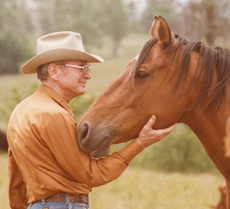 Market variables weren’t much of a concern for the late Guy Ray Rutland of Independence, Kansas.
Market variables weren’t much of a concern for the late Guy Ray Rutland of Independence, Kansas.
“I’d rather invest in horses than anything else I know,” Rutland told me in 1984, shortly after the failure of Oklahoma-based Penn Square bank and the beginnings of a far-reaching savings and loan scandal.
Rutland, who was born in 1917 and died in 1988, was the leading breeder of racing Quarter Horse register of merit qualifiers for nearly 40 years. His influence went far beyond racing, however. During his lifetime he was also recognized as a leading breeder of AQHA performance point earners, halter class winners, show ROM, and champions.
Cutting horse breeders are indebted to Rutland, as well, as the breeder of Dusty Socks, who can be traced back through her daughter, Bar Socks Babe, to the pedigrees of many contemporary champions, including 2008 NCHA Futurity champion Metallic Cat.
“I have always bred to be able to market all my horses,” Rutland said, as we topped a hill and looked down on more than 200 mares and foals, grazing cannon-deep in grass. “I’m almost ashamed to say that I have close to four hundred mares and fillies that I’ll breed this year. And I can name them all and tell you their breeding.”
As we neared the herd, here and there a mare sauntered away from the group to greet Rutland, who offered her an affectionate pat and related her pedigree to me.
Rutland was raised on a ranch in Okemah, OK and became interested in the horse business in the early 1940s, when a trader hired him to haul some “saddle horses” to Chicago. “He was giving $250 apiece for them and getting $1,500 to $2,000,” Rutland explained. “I thought that was a pretty good racket and that I’d better try it.”
It was in 1946, while scouting out a palomino stallion for a friend, that Rutland found the yearling Little Yellow Fox at a horse show in Ada, Oklahoma. “He was the color of a gold coin,” said Rutland, who bought the colt for $1,250 and renamed him Gold King Bailey.
Gold King Bailey won grand championships at the Denver and Fort Worth Stock shows and beat all comers on the racetrack, even as he began to produce future race, halter and performance winners. The first was Star Of Texas, who Rutland rode in a pasture on the first saddle and drove a cow and her calf out of a herd.
“The calf was following (his mother) so good that I cut the cow away from her calf and drove her to the house,” Rutland remembered. “That was the very first day in his life that he ever had a saddle on his back.
“There’s a lot of cow back in those Bailey horses.”
Gold King Bailey was the foundation of Rutland’s breeding program. The palomino stallion was sired by Hank H, by King, and out of Beauty Bailey, by Old Joe Bailey, out of an unnamed Yellow Wolf daughter. Rutland purchased mares for Gold King Bailey based on the era’s predominant bloodlines – King, Leo, Vandy and Three Bars, but also with a critical eye towards conformation.
“I look at a horse like I would a top athlete,” he said. “Wide at the shoulders and narrow at the hips, with good muscling and straight legs. I’m a fanatic about a good, straight hind leg and a good inside gaskin.”
Pacific Bailey, out of the Leo daughter Nell Bert McCue, succeeded Gold King Bailey as Rutland’s head sire in the late 1960s, and was joined by Bar Money, by Three Bars; Star Bright Moore, by Star Deck; and the Thoroughbred Carrara Marble, by Coldstream, among others.
Beginning in 1967, Rutland held annual fall production sales in Independence, where he offered all the weanlings from that year’s crop. “I would make more money if I kept the babies and sold them as yearlings,” he explained to me. “But I sell them as weanlings because I just don’t have the space to keep them. This is my only income, so my intention is to sell every one of them.”
Rutland built a 252-foot by 320-foot barn in 1973 to accommodate his sales. It contained 148 concrete stalls each measuring 16′ x 16′ and had an arena in the middle that could hold 30 portable stalls. Few who attended Rutland’s sales went home with an empty trailer, and they came back year after year.
“Make new friends, keep the old, the one is silver, the other gold,” was an adage Rutland printed across the botttom of his sale ads and in his catalogs. It was a standard for his personal and professional life.
“Most of my customers are poor folks like myself,” he said. “They want to buy one as good as the best for a lot less. It’s my customers that made me the leading breeder. They take the horses and train them and run them and prove them. I try to help them pick out the best I can for the price they want to pay.”
In spite of the depressed economy at the time I visited Rutland, he was still optimistic about the horse industry.
“I got a letter from someone awhile back who wanted to know what would be the best investment – gold, silver or oil,” he recounted. “I scratched all of those out and wrote in ‘horses.’
“We have our ups and downs, like anything else,” he added. “The economy hits us, but by the same token, it hits the farmer and the businessman. But I think I’ll just stay in there and try to raise the right kind of horses.”
The right kind of horse for Rutland, of course, was usually tempered with “Gold.”
